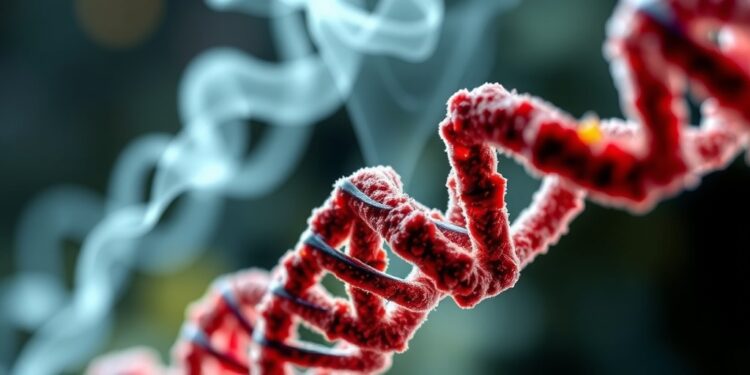
A groundbreaking study conducted by researchers from The Hebrew University of Jerusalem sheds light on the molecular underpinnings of how cigarette smoke can induce DNA damage and ultimately lead to lung cancer. The research spearheaded by Professor Sheera Adar and her graduate student Elisheva Heilbrun-Katz, in collaboration with experts from Duke University and the University of Massachusetts, delves deep into the effects of benzo[a]pyrene—one of the most harmful constituents found in cigarette smoke. This toxic component undergoes metabolic conversion in the body to form Benzo[a]pyrene diol epoxide (BPDE), a molecule known for its capacity to bind with DNA, resulting in significant disruptions of its normal functions.
Utilizing state-of-the-art genomic tools, the researchers meticulously explored the relationship between DNA structure, its chemical modifications, and susceptibility to damage inflicted by BPDE. The study found that certain regions of DNA exhibit a higher propensity for damage, particularly those that are more open and actively engaged in gene transcription processes. Notably, while these regions are indeed vulnerable, they also demonstrate a surprisingly enhanced capacity for cellular repair mechanisms. This duality underscores the complexity of interactions occurring within the genomic landscape, where both susceptibility to damage and the efficiency of repair can dictate the outcome of genetic integrity.
One of the critical revelations from this research highlights the role of transcription factors, the proteins responsible for regulating gene expression. The findings illustrate that while these factors can sometimes serve as protectors of DNA, shielding it from potential damage, they can also inadvertently increase a region’s vulnerability to harmful agents like BPDE. This nuanced relationship between transcription factors and DNA damage introduces a level of complexity in our understanding of genetic vulnerability, suggesting that the context in which these factors operate could determine their protective or harmful potential.
Moreover, the study emphasizes the importance of efficient DNA repair processes. Through meticulous experimentation, the researchers uncovered that regions of the genome capable of effective repair mechanisms tend to accumulate fewer mutations, even when these regions initially endure significant damage. This observation indicates that the efficiency of DNA repair in mitigating damage is perhaps more crucial than the absolute level of damage initially sustained. Therefore, the body’s inherent ability to recognize and rectify DNA lesions emerges as a key player in determining the likelihood of subsequent mutations, which are often precursors to oncogenic transformations.
The implications of this research are immense, particularly in understanding how smoking-related mutations unfold at a molecular level. The revelations about the interplay between DNA damage susceptibility and the reparative capabilities of various genomic regions could pave the way for novel strategies in cancer prevention and treatment. By enhancing our grasp on how smoking instigates mutagenic processes, targeted interventions can potentially be developed to bolster DNA repair mechanisms or to mitigate the damaging effects of toxic exposures such as cigarette smoke.
As the study was published in the reputable journal “Nucleic Acids Research,” it sets the stage for further exploration of the epigenetic factors that influence mutagenesis associated with smoking. This research highlights the intricate dance between environmental exposures and intrinsic genetic frameworks, illustrating how smoking can provoke a cascade of molecular events leading to oncogenic outcomes. Through increased awareness and understanding of these processes, individuals may be more empowered to make informed decisions regarding tobacco use and its associated risks.
Additionally, the findings might serve as a catalyst for further investigations into the genetic factors that determine an individual’s susceptibility to smoking-induced DNA damage. Particular focus could be directed toward identifying genetic variations that influence repair efficacy, offering potential biomarkers for assessing cancer risk among smokers. This could lead to personalized strategies in cancer prevention, where individuals might be monitored and treated based on their unique DNA repair profiles and genetic predispositions.
The multifaceted interactions outlined in this study present a robust platform for future research endeavors aimed at unraveling the complexities of cancer biology. By understanding the dynamics of DNA damage and repair in the context of tobacco exposure, researchers may uncover innovative therapeutic avenues that can counteract the carcinogenic effects of smoking. The emphasis on epigenetic landscapes and their role in shaping mutagenesis will undoubtedly inspire a new wave of inquiry into cancer research.
In a broader context, the study underscores the need for continued public health efforts to reduce tobacco consumption. As smoking remains a leading cause of preventable cancer, equipping the public with knowledge about the biological mechanisms behind smoking-related DNA damage can serve as a powerful tool in advocacy and educational initiatives. Efforts to demystify the scientific complexities associated with smoking may resonate more effectively with diverse audiences, potentially fostering a deeper understanding of the risks involved with tobacco use.
In conclusion, the research provides profound insights and raises critical questions about the molecular dimensions of how environmental factors, such as cigarette smoke, interact with our genetic makeup. Understanding these interactions is crucial in the fight against lung cancer and highlights the necessity for ongoing efforts in both research and public health domains. As scientists continue to unveil the intricate relationship between our environment and our genetics, it is essential to channel these insights into actionable strategies for mitigating cancer risks and enhancing health outcomes.
Subject of Research: Cells
Article Title: The epigenetic landscape shapes smoking-induced mutagenesis by modulating DNA damage susceptibility and repair efficiency
News Publication Date: 28-Feb-2025
Web References: 10.1093/nar/gkaf048
References: Nucleic Acids Research
Image Credits: Not provided
Keywords: DNA damage, Genomic DNA, Tobacco, Lung cancer, Cancer research, Cancer risk, Disease prevention
Tags: benzo[a]pyrene and DNA interactionscancer risk factors associated with smokingcollaboration between universities in cancer researchDNA repair mechanisms and susceptibilityenvironmental factors and DNA damagegene transcription and DNA vulnerabilitygenomic tools in cancer researchimpact of toxic compounds on DNAmolecular mechanisms of cigarette smokeProfessor Sheera Adar research studysmoking-induced lung cancer riskunderstanding DNA damage in cancer development





